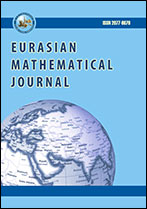|
This article is cited in 2 scientific papers (total in 2 papers)
Completeness of the exponential system on a segment of the real axis
A. M. Gaisina, B. E. Kanguzhinbc, A. A. Seitovabc
a Institute of Mathematics with
Computing Centre,
Subdivision of the Ufa Federal Research Centre
of the Russian Academy of Sciences,
Bashkir State University,
112 Chernyshevsky St,
450008 Ufa, Russia
b Institute of Mathematics and Mathematical Modeling,
125 Pushkin St,
050010 Almaty, Kazakhstan
c Al-Farabi Kazakh National University,
71 al-Farabi Ave,
050040 Almaty, Kazakhstan
Keywords and phrases:
Lebesgue-Stieltjes integral, indicatrix of the growth, Borel adjoint diagram, Beurling-Malliavin
multiplier theorem, Paley-Wiener theorem, Cartwright class.
Received: 21.02.2021
Citation:
A. M. Gaisin, B. E. Kanguzhin, A. A. Seitova, “Completeness of the exponential system on a segment of the real axis”, Eurasian Math. J., 13:2 (2022), 37–42
Linking options:
https://www.mathnet.ru/eng/emj436 https://www.mathnet.ru/eng/emj/v13/i2/p37
|

| Statistics & downloads: |
| Abstract page: | 180 | | Full-text PDF : | 64 | | References: | 32 |
|




 Contact us:
Contact us: Terms of Use
Terms of Use
 Registration to the website
Registration to the website Logotypes
Logotypes








 Citation in format
Citation in format 
